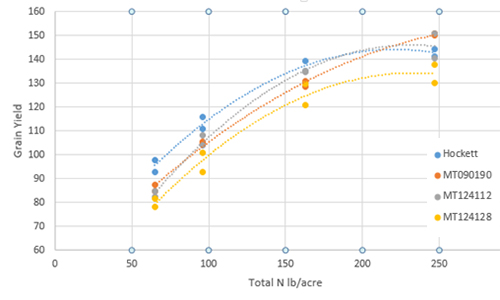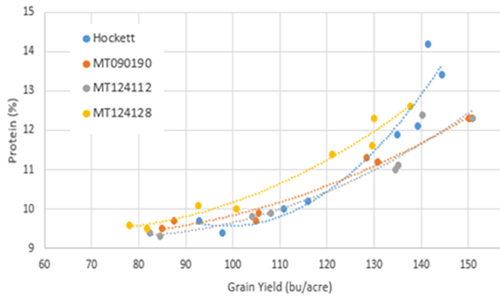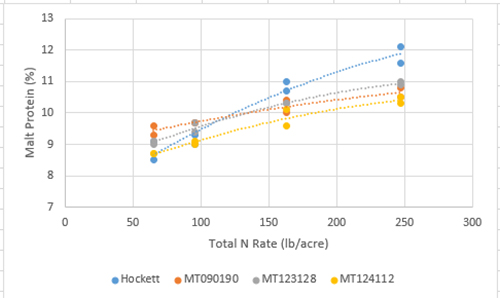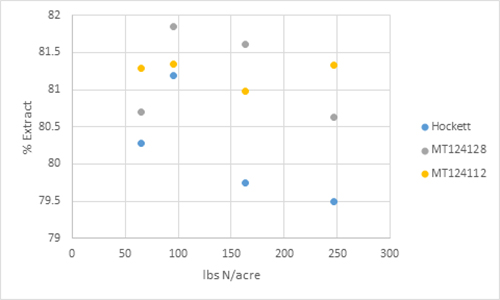Low Protein Lines

Using a chapon test we are able to visually show what areas of a grains endosperm are hydrated or not. White starchy areas are un-hydtrated, glassy brown areas are hydtrated. These example lines demonstrate high and low protein and the resulting hydration associated with each at the end of steep.
Why is high protein a problem for maltsters?
- Protein (which is hydrophobic) inhibits endosperm hydration
- More protein = more time to malt
= poor malt extract
When a grower’s barley is rejected for malt due to abiotic stress it is usually due to high grain protein. The percentage of grain protein increases with abiotic stress because lack of water or increased heat interferes with starch deposition.
The Low Protein Trial looks at the quality of lines having a
-Low Protein Gene-
Hypothesized action of the low protein gene:
This gene encodes a transcription factor which delays the development of the shoot apical meristem (senescence) allowing additional starch to be deposited during grain fill. This results in increased yields and proportionally creates grain with low protein and high starch.
The low protein gene was identified in the variety known Karl, a six-row barley, and two-row sister lines were created by crossing Karl to the locally adapted malt line Hockett. This study works to identify the best performing lines from this cross when considering agronomics and malt quality.
Intrastate Testing of Low Protein Lines:
Several lines have high yields and low proteins when evaluating multiple location years. Several of the new lines also have improved quality. Under dryland conditions the new lines do not yield as high as Hockett, but have more stable quality. Several lines increased grain fill by earlier heading. The top 4 dryland lines have been submitted for AMBA testing.
Management - what are the best practices fro growing these low protein lines?
A dilemma for growers is that while increasing nitrogen increases yield it also decreases quality. Because growers are paid by yield not by quality, they want to manage for maximum yields. However, if they over estimate yield potential and apply too much nitrogen plumps can be reduced and proteins raised so much that barley is rejected. To determine the best management practices for the low protein lines, three sister lines with the low protein gene and a parent line (Hockett) without the low protein gene were tested at four nitrogen and two sulfur levels at the Central Ag. Research Center (CARC; dryland) near Moccasin, the Southern Ag. Research Center (SARC; irrigated) near Huntley, and the Post Farm (dryland) just outside Bozeman. Nitrogen was applied as urea at 0, 0.5, 1.0, and 1.5 times the current N recommendation of 1.2 lb N for each expected bushel per acre yield after accounting for residual soil nitrate-N in the profile.
Sulfur is not always limiting in Montana soils, but deficiencies are common in the central part of the state, so two sulfur treatments were included (a 0 and 20 lb/ac rate as sulfate).
Phenotypic data included yield, grain protein, plumps and malt quality. The MSU Barley Quality Laboratory provided malt quality analysis following ASBC methods.
Low Protein Lines - Management Results


Response curve of grain yield to nitrogen
This figure indicates that the four lines have similar change in yield with increasing nitrogen. With yield response to nitrogen reaching a plateau at ~160lbs N/acre. On average, for each treatment Hockett yields more than daughter lines.
% Protein increases with grain yield
This figure compares yield to protein, as yields increase so do proteins for all the lines. However, the daughter lines have significantly lower protein than Hockett at higher yields. Thus, the low protein lines could be grown at higher yield potential and still result in lower protein.


Malt protein response to nitrogen
In this figure comparing malt protien to nitrogen there is a similar response, with daughter lines having significantly lower proteins at higher nitrogen rates.
Malt extract response to nitrogen
This figure shows the response of malt extract to nitrogen. Note that two of the daughter lines have more stable extract across treatments. These results suggest that the low protein lines could be grown at higher yield potential than Hockett and still have good quality, allowing growers to produce more on less land. In other words, MT124112 and MT124128 could be grown at 130 to 140 bu/acre and have better quality than Hockett at 90 bu/acre.
| Montana Offstation Nursery 2017 - 10 Dryland Locations | ||||||
| Balster | 63.00 | 13.03 | 62.89 | 48.27 | 60.81 | 179.22 |
| Bill Coors 100 | 59.98 | 13.54 | 77.19 | 48.75 | 55.63 | 182.36 |
| Genie | 64.08 | 12.45 | 74.87 | 50.36 | 56.33 | 182.88 |
| Growler | 54.30 | 14.01 | 66.33 | 46.91 | 60.54 | 182.02 |
| Hockett | 60.60 | 12.45 | 75.83 | 50.78 | 62.58 | 177.14 |
| Merit 57 | 49.80 | 13.43 | 57.97 | 49.35 | 62.68 | 179.10 |
| Metclafe | 61.56 | 13.53 | 70.67 | 50.04 | 64.51 | 176.14 |
| Moravian 165 | 60.26 | 13.18 | 70.87 | 49.48 | 65.27 | 175.58 |
| Odyssey | 61.70 | 12.66 | 75.10 | 48.84 | 57.60 | 175.38 |
| Synergy | 60.50 | 12.71 | 73.39 | 49.01 | 63.47 | 178.76 |
| MT124128 | 62.61 | 11.55 | 87.61 | 52.82 | 60.86 | 172.66 |
| GRAND MEAN | 60.96 | 13.54 | 52.49 | 49.20 | 61.22 | 178.31 |
| CV | 13.25 | 5.54 | 16.35 | 2.48 | 6.46 | 6.81 |
| LSD | 4.32 | 0.40 | 4.87 | 0.65 | 2.12 | 9.78 |
| Total Reps | 27 | 27 | 24 | 27 | 27 | 12 |
Summary of Montana 2017 Offstation Dryland Nursery
This table reports the agronomic data for the top performing lines across the state in dryland locations during the 2017 drought. Note that MT124128 out performed all lines in test weight, plumps and protein even under drought.
